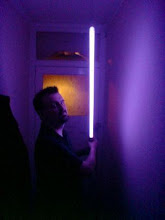A living castle, born of blood and eager to work its will on the people that it ensnares. A castle with plans that must come to fruition, no matter what the cost in human lives… Hang on, haven’t we heard this all before? Aren’t we just looking at yet another haunted house story and isn’t that all just a little bit old now…?
Everything derives from something; I’m going to stick my head out and say that nothing is really original, there’s only stuff that you haven’t read yet. What really matters is how the writer treats his material, it’s the story that counts.
‘Ragemoor’ riffs on some long established themes but the resulting story is nothing short of superb. It’s an unsettling read that I personally had to finish off in one sitting (okay, ‘standing’, I was on the tube…)If you’re a fan of haunted houses, insect men and Lovecraft then I’d be very surprised if you haven’t given it a go already.
A large part of the impact that ‘Ragemoor’ has comes in the form of Richard Corben’s striking artwork. I am a big fan of Corbens contribution to the ‘Cimmeria’ storyline and he proves more than able to step up and deliver over the course of an entire book.
Corben displays a real ability to capture love, loss and outright screaming fear in the faces of the cast; it becomes all too easy to feel that fear yourself once you see it in them and that does half the job of the plot all by itself. Corben also captures the hellish environs of Ragemoor beautifully. It’s bleak and desolate but with an air of danger that hits you hard when it comes to the fore. If that’s not enough, Corben also delivers in terms of the weird horror that lurks at Ragemoor’s heart. Worm men and insect men are only half of it…
All of this is delivered in black and white, there is nothing to distract the reader from the horror and that’s as it should be.
This book isn’t all about Corben though. Jan Strnad gives us a plot that clearly wants to be free of the ‘four issue mini-series’ restriction but has a lot to say for itself in the meantime. It’s all credit to Strnad that he can have Herbert and his manservant, Bodrick, fight against Ragemoor and then for it in such a short space. It’s a transition that is tightly plotted and all too plausible. Sometimes the devil you know really is better than the horrors that lurk beneath…
My only real criticism is that you can see how it will ultimately end as Strnad doesn’t really give himself room to do a lot more than tell what is ultimately a haunted house story with accompanying family curse. It’s the journey that really counts here though. Strnad really lays on the weird here and this means hints of a universe even more dark and horrifying than the castle itself. And the castle itself is pretty terrifying, just ask poor Anoria…Now there is a sub-plot worth following with the course of true love and human greed meaning nothing to a castle fighting an eternal battle of its own.
Everything devolves into madness, come the end, and this lends proceedings a real frantic air and a burst of energy just at the right time. To close the book with the same line that opened it was a masterful stroke as well; an unsettling way of demonstrating the grim implacability of Ragemoor.
I wouldn’t have minded seeing ‘Ragemoor’ developed a little further (ten issues maybe?) although you could just as easily say that it’s hearkening back to its pulp roots. I can’t really complain though given this intense dose of weird horror that doesn’t leave you after the book is closed and put down. I think I’m going to be a regular visitor to Ragemoor, I’m just glad that I don’t have to live there…
Nine and a Half out of Ten
Subscribe to:
Post Comments (Atom)


No comments:
Post a Comment